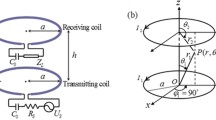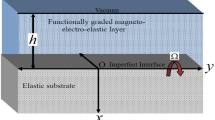Abstract
This is a review of two electrical equivalent circuits for multi-element magnetostatic wave transducers. The two circuit models are identified as a transmission line and a two terminal model. Both models have been extended to all three principal MSW modes of propagation to the point where computer programs have been written to plot phase and amplitude response as measured by commercial network analyzers. A review is provided of the basic assumptions, similarities and differences, advantages and disadvantages, and limitations of the two models. The useful range of them covers many cases of practical interest in the one to twelve Ghz frequency range.
Similar content being viewed by others
References
H.J. Wu, C.V. Smith, J.H. Collins, and J.M. Owens, “Bandpass filtering with multibar magnetostatic surface wave microstrip transducers,” Electronics Letters,13, 20, 610–611, (1977).
H.J. Wu, C.V. Smith, Jr., and J.M. Owens, “Bandpass filtering and input impedance characterization for driven multielement transducer pair-delay line magnetostatic wave devices,”J. Appl. Physics 50 (3), 2455–2457, (1979).
J.C. Sethares, “Magnetostatic surface wave transducers,”IEEE Trans on Microwave Theory and Techniques,MTT-27, 11, 902–911, (1979).
J.C. Sethares and I.J. Weinberg, “Apodization of variable coupling MSSW transducers,”J. Appl Physics 50 (3), 2458–2460, (1979).
A.K. Ganguly and D.C. Webb, “Microstrip excitation of magnetostatic surface waves: theory and experiment,”IEEE Trans Microwave Theory and Techniques,MTT-23, 998–1006, (1975).
A.K. Ganguly, D.C. Webb, and C. Banks, “Complex radiation impedance of microstrip — excited magnetostatic surface waves,”IEEE Trans MTT, (1978), 444–447.
P.R. Emtage, “Interaction of magnetostatic waves with a current,”J. Appl Phys,49, 4475–4484, (1978).
J.P. Parekh, “Theory of magnetostatic forward volume wave excitation,”J. Appl Phys 50 (3), 2452–2454, (1979).
I.J. Weinberg and J.C. Sethares, “Magnetostatic Volume Waves,”IEEE Trans.,MTT-32, 4, 463, (1984).
I.J. Weinberg, Final Report, AFOSR University Resident Research Program, (1982–1983).
V. Lander and J.P. Parekh, “Tunable MSW Oscillators Employing Narrowband Delay Lines,”1983 Ultrasonics Symposium Proceedings,1, 232–237, 83CH1947-1.
Author information
Authors and Affiliations
Rights and permissions
About this article
Cite this article
Sethares, J.C., Weinberg, I.J. Theory of MSW transducers. Circuits Systems and Signal Process 4, 41–62 (1985). https://doi.org/10.1007/BF01600072
Received:
Revised:
Issue Date:
DOI: https://doi.org/10.1007/BF01600072




